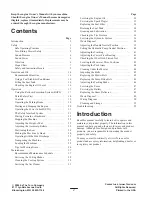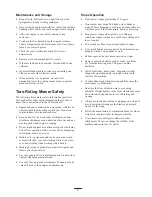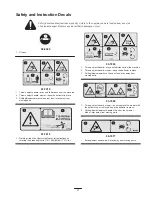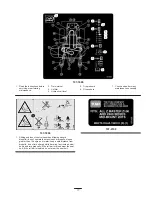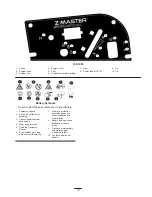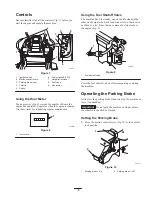
4
Preparation
•
While mowing, always wear substantial footwear and
long trousers. Do not operate the equipment when
barefoot or wearing open sandals.
•
Thoroughly inspect the area where the equipment is to
be used and remove all objects which may be thrown by
the machine.
•
Warning—Fuel is highly flammable.
–
Store fuel in containers specifically designed for this
purpose.
–
Refuel outdoors only and do not smoke while
refuelling.
–
Add fuel before starting the engine. Never remove
the cap of the fuel tank or add fuel while the engine
is running or when the engine is hot.
–
If fuel is spilled, do not attempt to start the engine
but move the machine away from the area of
spillage and avoid creating any source of ignition
until fuel vapors have dissipated.
–
Replace all fuel tanks and container caps securely.
•
Replace faulty silencers.
•
Before using, always visually inspect to see that the
blades, blade bolts and cutter assembly are not worn or
damaged. Replace worn or damaged blades and bolts in
sets to preserve balance.
•
On multi-bladed machines, take care as rotating one
blade can cause other blades to rotate.
Operation
•
Be alert, slow down and use caution when making
turns. Look behind and to the side before changing
directions.
•
Do not operate the engine in a confined space where
dangerous carbon monoxide fumes can collect.
•
Mow only in daylight or in good artificial light.
•
Before attempting to start the engine, disengage all
blade attachment clutches and shift into neutral.
•
Do not use on slopes greater than 15 degrees.
•
Remember there is no such thing as a safe slope. Travel
on grass slopes requires particular care. To guard
against overturning:
–
do not stop or start suddenly when on a slope;
–
use slow speeds on slopes and during tight turns;
–
stay alert for humps and hollows and other hidden
hazards;
•
Use care when pulling loads or using heavy equipment.
–
Use only approved draw bar hitch points.
–
Limit loads to those you can safely control.
–
Do not turn sharply. Use care when reversing.
•
Watch out for traffic when crossing or near roadways.
•
Stop the blades rotating before crossing surfaces other
than grass.
•
When using any attachments, never direct discharge of
material toward bystanders nor allow anyone near the
machine while in operation.
•
Never operate the machine with damaged guards or
without safety protective devices in place.
•
Do not change the engine governor settings or
overspeed the engine. Operating the engine at excessive
speed can increase the hazard of personal injury.
•
Before leaving the operator’s position:
–
disengage the power takeoff and lower the
attachments;
–
change into neutral and set the parking brake;
–
stop the engine and remove the key.
•
Disengage drive to attachments, stop the engine, and
disconnect the spark plug wire(s) or remove the ignition
key
–
before clearing blockages or unclogging chute;
–
before checking, cleaning or working on the lawn
mower;
–
after striking a foreign object. Inspect the lawn
mower for damage and make repairs before
restarting and operating the equipment;
–
if the machine starts to vibrate abnormally (check
immediately).
•
Disengage drive to attachments when transporting or
not in use.
•
Stop the engine and disengage drive to attachment
–
before refuelling;
–
before removing the grass catcher;
–
before making height adjustment unless adjustment
can be made from the operator’s position.
•
Reduce the throttle setting during engine run-out and, if
the engine is provided with a shutoff valve, turn the fuel
off at the conclusion of mowing.


